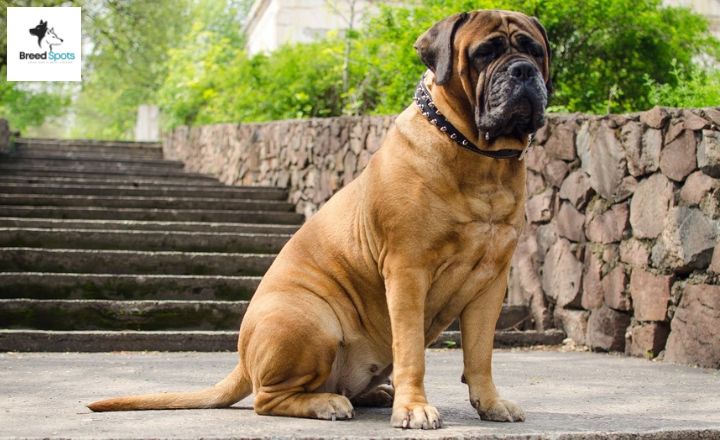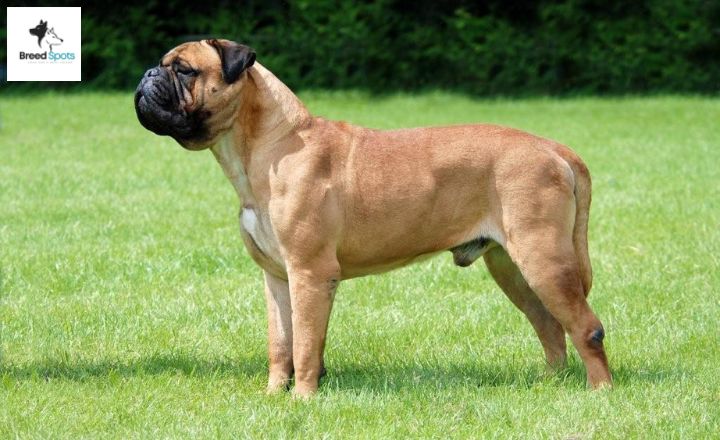Learn more about the Bullmastiff Growth Chart and the 7 essential tips to help your giant dog grow healthy and strong.
Known for their incredible loyalty and protective instincts, these magnificent dogs can weigh between 100 and 130 pounds when fully grown, making them an impressive presence in any household.
However, the journey from fluffy puppy to majestic adult is filled with crucial stages of growth that demand understanding and attention.
Like humans, Bullmastiffs experience rapid physical development during their early months, which can significantly influence their overall health and well-being.
In this article, we’ll delve into the essential components of a Bullmastiff growth chart to help you track your pup’s progress accurately.
| Age (Months) | Weight (lbs) – Male | Weight (lbs) – Female | Height (Inches) – Male | Height (Inches) – Female |
| 1 | 12-15 | 10-12 | 10-12 | 9-11 |
| 3 | 30-40 | 25-35 | 15-18 | 14-17 |
| 6 | 60-70 | 55-65 | 20-24 | 19-23 |
| 9 | 80-100 | 70-90 | 22-26 | 21-25 |
| 12 | 100-120 | 85-105 | 85-105 | 23-26 |
| 18 | 110-130 | 95-115 | 25-27 | 24-26 |
| 24 (Adult) | 110-130 | 95-115 | 25-27 | 24-26 |
Bullmastiff Growth Chart By Age

Understanding the Bullmastiff growth chart by age can be fascinating for dog owners and enthusiasts. Bullmastiffs are like gentle giants in the doggie world.
Their growth spurts are impressive and fascinating to watch. Let’s grow through them.
Birth To 4 Weeks
The first four weeks of a Bullmastiff’s life are a whirlwind of rapid growth and development, marking the critical foundation for their future as loyal companions.
Just hours after birth, these adorable puppies begin exhibiting instinctual behaviors; they crawl toward their mother’s warmth and nourishment.
At this stage, they rely entirely on her milk for nutrition, hydration, and antibodies that bolster their immune systems against infections.
Observing them cluster together in a comfortable puppy pile is heartwarming. It highlights both their need for warmth and the innate social structures forming among littermates.
2 To 3 Months
At 2 to 3 months old, Bullmastiff puppies are a whirlwind of energy and charm that can easily win over any dog lover’s heart.
This is the stage where their unique personalities truly begin to shine. A delightful mix of curiosity and clumsiness often characterizes them.
They’re still in their initial learning phase, responding eagerly to socialization opportunities that will shape their future temperament.
During this time, introducing them to various sights, sounds, and experiences boosts their confidence and helps cement lifelong behaviors.
3 To 6 Months
During the 3 to 6-month stage, bullmastiff puppies exhibit an incredible blend of playful energy and develop personality traits that make them particularly endearing.
Their sturdy bodies become more pronounced as they grow, showcasing the breed’s impressive size and strength.
This is a critical phase for their socialization; exposing them to different environments, people, and other animals can significantly influence their adult temperament.
Owners must introduce new experiences gently, ensuring these puppies build confidence without feeling overwhelmed.
Read This Article: American Bully Growth Stages: Is Your Bully The Right Size?
6 To 9 Months
Between 6 and 9 months, Bullmastiff puppies transition from playful, wobbly bundles of joy into striking young adults filled with energy and curiosity.
This stage is crucial for their socialization; exposure to different environments, people, and other pets shapes their temperament.
Engaging them in diverse experiences can help cultivate the confident behavior that these gentle giants are known for as adults.
Consider taking trips to the dog park or enrolling them in puppy classes—these outings stimulate their minds and fortify the bond you share.
9 To 12 Months
At 9 to 12 months, bullmastiff puppies transition from playful adolescents into their more mature selves.
This is a critical period where they exhibit an exhilarating mix of puppy enthusiasm and burgeoning independence.
During this time, socialization becomes even more vital; exposing them to various environments, people, and pets can significantly shape their temperament.
Bullmastiffs are known for their protective instincts, and early interactions help them learn to differentiate between friend and foe effectively—skills that will serve them well in adulthood.
12 To 18 Months
At 12 to 18 months, Bullmastiffs are at a fascinating crossroads between puppy exuberance and mature behavior.
This stage is often marked by a noticeable growth spurt—both physically and mentally. Their playful antics may still linger as they transition into adulthood, but their blossoming confidence stands out.
Socialization during this period is crucial; exposing them to various environments, people, and other animals will help mold their temperament into that of a well-rounded companion. Training becomes essential as they assert their independence around this age.
Patience and consistency should be your guiding principles because a bullmastiff’s stubborn streaks can emerge more prominently now.
Positive reinforcement builds trust and strengthens the bond between you and your pet.
18 To 24 Months
As your Bullmastiff enters the 18 to 24-month stage, it is on the brink of adulthood but still carries some youthful exuberance.
This transitional phase is crucial for their development, as their physical size may now rival that of an adult dog while their mental maturity is still catching up.
Training should remain consistent and engaging—this is not just about obedience but also about nurturing a strong bond through shared activities and challenges, such as agility courses or interactive games.
Socialization during this period becomes vital; exposing them to different environments, people, and other animals can significantly shape their temperament.
A well-socialized Bullmastiff at this age can showcase unparalleled confidence and stability in various situations.
7 Tips To Help Your Bullmastiff Grow Strong And Healthy

Let’s dive into seven essential tips to help your Bullmastiff thrive and become the magnificent, gentle giant they are meant to be.
1. Feed Them Right
Feeding a Bullmastiff requires a thoughtful approach that balances their size, energy level, and unique nutritional needs.
These gentle giants thrive on high-quality dog food rich in protein, which supports their muscular build while incorporating healthy fats for sustained energy.
Look for formulas specifically designed for large breeds; they help maintain optimal bone health and reduce the risk of joint issues later in life.
Pay attention to the ingredient list. Opt for whole meats over by-products and include wholesome grains or vegetables that aid digestion.
2. Keep Them Active
Bullmastiffs, known for their impressive size and strength, are surprisingly agile and need consistent activity to maintain their health and happiness.
Engaging them in exercise doesn’t just keep them fit; it also taps into their innate instincts. Activities like scent work or agility training can be beautifully rewarding for this breed, offering mental stimulation and physical exertion.
Imagine your Bullmastiff navigating an obstacle course or working through scent trails—this keeps them active and deepens the bond between you two as they learn to trust your guidance.
3. Know Their Genes
Understanding your Bullmastiff’s genetics is essential for responsible ownership and breeding. These dogs are a fascinating blend of traits inherited from their ancestors, primarily the English Mastiff and the Bulldog.
This genetic background influences their physical attributes and plays a pivotal role in determining their personality and health concerns.
For instance, knowing whether your Bullmastiff leans more towards the Mastiff side can help you anticipate behavioral tendencies, such as loyalty or protective instincts. At the same time, Bulldog traits might contribute to playful energy.
4. Regular Vet Visits
Regular vet visits are crucial for Bullmastiffs, not only to monitor their health but also to enhance their quality of life.
These gentle giants are prone to specific conditions such as hip dysplasia and certain heart disorders, making routine check-ups vital for early detection and management.
Moreover, regular examinations can help keep vaccinations current and address behavioral issues before they escalate.
By prioritizing regular vet visits, owners ensure that their Bullmastiffs enjoy a long, healthy life filled with love and companionship.
5. Train And Socialize
Training and socializing Bullmastiffs is essential to nurturing these gentle giants into well-mannered family companions.
Their instincts as protectors can sometimes lead to overly cautious or reserved behavior around strangers, making early socialization critical.
Introduce your Bullmastiff to various environments—parks, pet stores, and even friendly gatherings—where they can encounter different people and animals. This exposure helps them develop confidence and discern between friend and foe.
Incorporating positive reinforcement techniques during training sessions works wonders for these intelligent dogs.
They thrive on rewards, whether treats or affectionate praise, making learning enjoyable for you and your Bullmastiff.
6. Provide Them With A Safe Place
Creating a haven for your Bullmastiff goes beyond simply providing four walls; it’s about fostering an environment where they feel secure and understood.
These gentle giants, known for their protective instincts and affectionate behavior, thrive in spaces that cater to their needs.
Establishing a dedicated area within your home—perhaps a cozy corner with their favorite bed, soft blankets, and toys—can offer them a sanctuary where they can retreat whenever they feel overwhelmed or want some downtime.
Additionally, incorporating elements of mental stimulation can transform this safe space into an engaging refuge.
7. Monitor Their Weight
Monitoring the weight of your Bullmastiff is crucial for their health and longevity. These magnificent dogs can quickly turn into couch potatoes, and their natural inclination towards a sedentary lifestyle, combined with a love for food, often leads to obesity if not carefully managed.
Regular weigh-ins at home or veterinary visits help you monitor their weight and notice any sudden changes that might indicate underlying health issues.
A fascinating approach to keeping your Bullmastiff fit is incorporating varied physical activities tailored to their personality and energy levels. Instead of standard leash walks, consider agility training or interactive fetch games that stimulate the mind and body.

